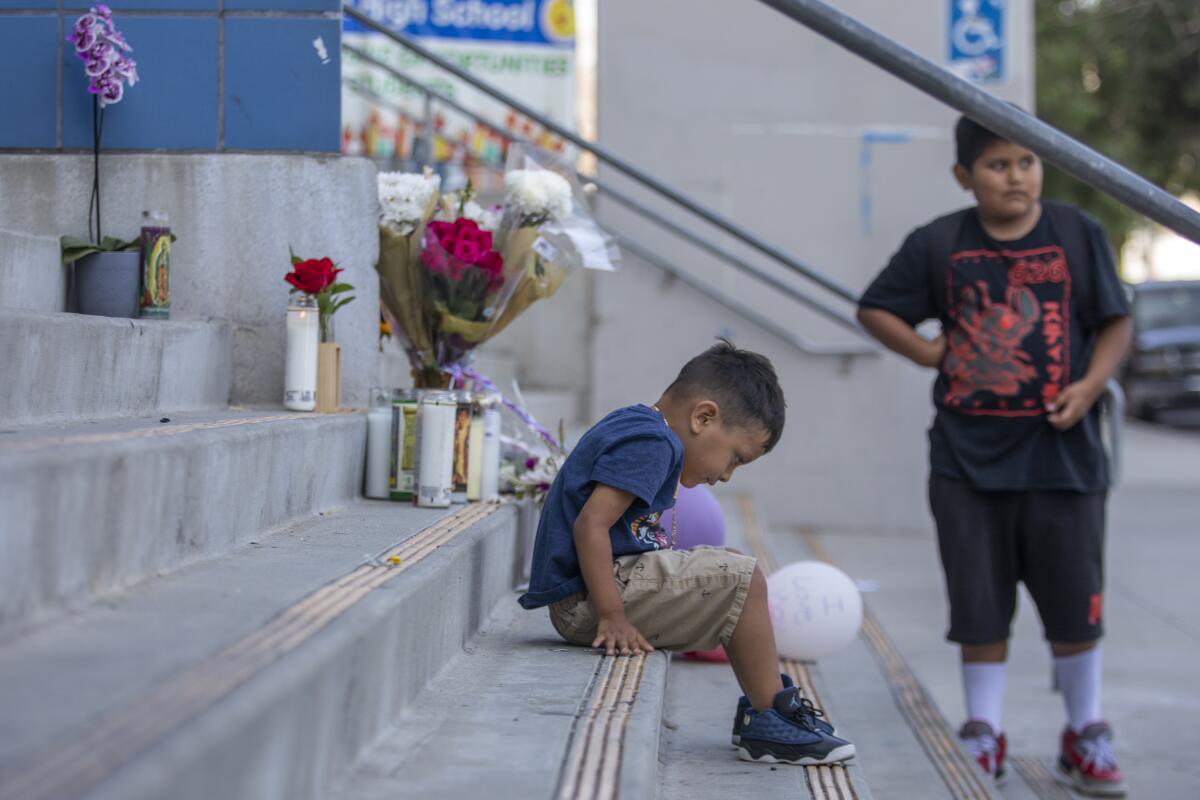Commentary: Fentanyl feels like the monster coming for our kids. How do parents talk about it?

- Share via
It’s been a banner few years for parents having to talk about deadly things with their children. A pandemic. Mass shootings. Climate change. The end of democracy.
And now fentanyl.
Catastrophes like COVID-19 and global warming are problems on a scale so vast that they can be difficult to understand, let alone explain to our children (and believe me, I’m trying).
Fentanyl, on the other hand, feels like the real monster hiding on the playground, one that poses a deadly risk not to humanity, but to your child. And a surge in overdoses is forcing parents to talk about drugs with their children in ways we never imagined, and without the kind of advice this threat demands.
In recent weeks, nine students in the Los Angeles Unified School District have suffered overdoses; one student, 15-year-old Melanie Ramos, died Sept. 13 at Helen Bernstein High School in Hollywood from a suspected fentanyl poisoning.
The word “poisoning” here is key: Melanie reportedly did not know she was ingesting fentanyl, a synthetic opioid many times more powerful and cheaper than heroin. Illicit drug makers figured they can make more money by cutting their pills and powders with fentanyl, the survival of their users be damned. Melanie apparently thought she was swallowing Percocet.
Right now, if you’re thinking no teen should take an opiate in the first place, ask yourself: How old were you when you first experimented with drugs? What risks did you take in high school that didn’t kill you? Melanie behaved in a way not unlike what 15-year-olds have been doing for ages. But she died because she did it in 2022, when “Percocet” pills are sometimes fentanyl.
The night after Melanie died, we had our family conversation about drugs and alcohol years earlier than planned. My three children are young — two fifth-graders and a first-grader — but there seemed no reason to delay. My wife, a teacher, was forthright and calm; I was less calm.
She built on past conversations with our children about being in charge of what we do with our bodies; this time, the focus was what we put into them. When it was my turn to speak, I felt as if I were reliving the bad old days of the 1980s, when Mr. T and Nancy Reagan told us to just say no. I know that message didn’t work for me or many of my friends.
Unsatisfied by my flailing and puzzling over how parents can project calm amid such a novel and unforgiving threat, I sought the advice of Maribeth Henry, a licensed family therapist and podcast host who recently retired from teaching parenting classes at Pasadena City College. (She also happens to have been my P.E. teacher in first grade — small world.)
She put the talks we need to have with our children in the context of a longer-term lesson on consent — the idea that you have control with what happens to your body. She said a discussion with my 10-year-olds on fentanyl could build on the idea that other people are not allowed to treat your body in ways you don’t want. Henry says an age-appropriate way to refer to these bad actors is as “tricky people.” Now, there are “tricky people” selling fentanyl to kids like Melanie, even though Melanie did not consent to having that deadly drug put into her body.
Of course, Henry says it’s important to have continuing discussions over many years and build trust with your children as they grow.
Right now, though, the threat posed by fentanyl is immediate, grave and pervasive, and emergency measures need to be taken. “Let’s get Narcan in all the high schools,” Henry told me. And in fact, Los Angeles school district officials recently announced that all schools will be stocking that overdose reversal drug.
But emergency measures won’t be enough if we fail to address the “why” of increased drug use. Henry says people in her profession are sadly unsurprised by this crisis. What’s also needed, she says, is to “uptick the therapists and the support in these communities, too.”
More to Read
A cure for the common opinion
Get thought-provoking perspectives with our weekly newsletter.
You may occasionally receive promotional content from the Los Angeles Times.











